Millennium Large Square Bass RecordersWhy Make Large Basses?In order to match the pitch of renaissance stringed instruments in consort, the standard recorder ensemble with a great bass on the lowest part is actually one octave too high. If the lowest parts were played on a contra-greatbass which sounds one octave below the great bass and the top parts performed on a good free speaking modern tenor, in place of a piercing descant, the effect would be to reproduce the same rich majesty in such repertoire when performed on viols. The other reason for making extra large bass recorders is to strengthen the bottom end of recorder orchestras, now increasingly popular with recorder players all around the world, where large bass recorders double the lowest lines or can even play independent lines of their own. Square recorders fitted with our modern keywork can be played easily by all and all Dolmetsch large basses are designed to function easily over two octaves or more.
Why Consider the Millennium Series?
Dolmetsch have been making recorders for over 85 years and early keyboard instruments for a number of decades longer. Although the idea of a square recorder is not new, previous attempts have tended to look rather utilitarian. At Dolmetsch, we wanted to build an instrument that was no less attractive to the eye than its sound was to the ear. Cherry wood is a very beautiful light-weight timber, and for this reason we have decided to veneer our instruments with this striking material. The key system designed jointly by Dolmetsch and master flute maker Peter Worrell is particularly hard wearing and reliable - parts are cast, assembled and finally gold-plated to produce a non-tarnishing finish. Optimally sprung, the action is positive and light, the stretch between the key touch pieces is very little more than that on a standard treble/alto recorder, and the voicing is remarkably responsive throughout the two octave plus range.
Models
- Great Bass in C (8ve below Tenor) a=440Hz.; a=415Hz.
- Contra Bass in F (8ve below Bass) a=440Hz.; a=415Hz.
- Contra Great Bass in C (8ve below Great Bass) a=440Hz.; a=415Hz.
- Double Contra Bass in F (8ve below Contra Bass) a=440Hz.; a=415Hz.
Latest Information
- Millennium Great Basses are now in production
- Millennium Contra Basses are now in production
- Prototype work on Millennium Contra Great Bass is now in progress
- Millennium Contra Great Bass production is expected to start Spring. 2007
- Millennium Contra Great Bass delivery is expected from Autumn 2007
- Prototype work on Millennium Double Contra Bass will start late in 2007
- Download the Millennium Great Bass Care Leaflet
- Download the English/Baroque Fingering Chart
Millennium Series Specifications
- the great bass recorder is in three sections
- the contrabass recorder is in four sections
- square cross-section tapering bore
- gold-plated keywork on all tone holes - finger width is no barrier to playing these large basses
- close to silent keywork - clatter-free even when playing at speed
- hand spacing for each bank of keys similar to that on a treble/alto recorder
- an easy-to-use 'natural-action' octave key mechanism (similar to a saxophone speaker key)
- the thumb touchpiece lies directly behind the first & second finger of the left hand
- two octave plus fully chromatic range - double keys for both bottom holes
- free and full speaking from the bottom to the top of the range
- no hard-to-turn socket/tenon joints which are found on cylindrical instruments
- absolutely no hand or wrist strain when assembling or disassembling the instrument
- compression catches simply lock the sections together - absolutely no leaks!
- cherry wood solid & veneer - durable teak oil finish
- hardwood tone hole liners for tonal & mechanical strength
- brass metal crook with hardwood wooden mouthpiece
- end-pin for seated use on the Millennium Great Bass
- floor standing Millennium Contra Bass & and larger models
- a fully-fitted and lined hardwood carrying case (this is an option for which there is a supplementary charge)
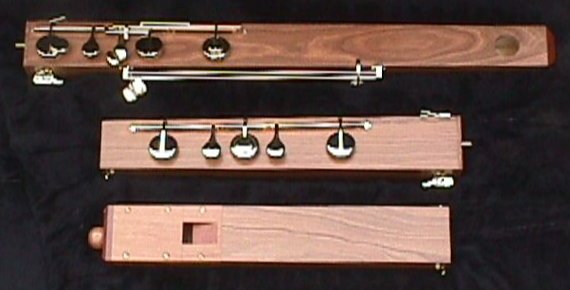
Millennium Great Bass with gold plated keys and cherry wood veneered finish
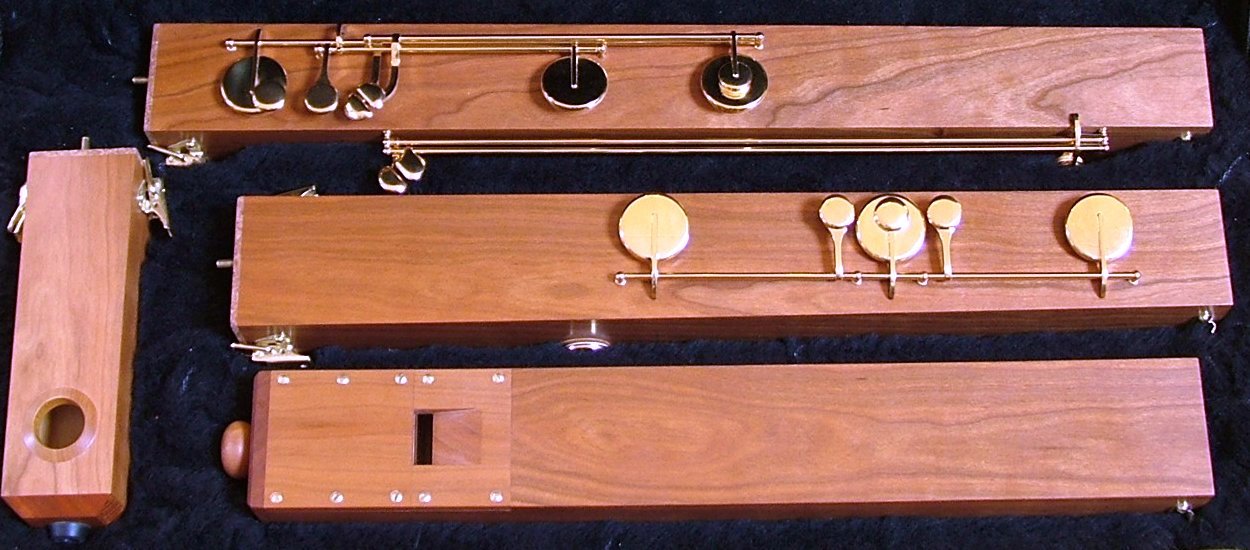 Millennium Contra Bass with gold plated keys and cherry wood veneered finish
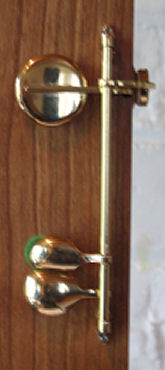 | | The ergonomically designed thumbkey (lower) and octave speaker key (upper) mechanism on the Millennium Great Bass and Contra Bass recorders. When playing in the lower octave, the thumb rests on the lower key to close and open the main thumbhole (which is normally open). By flexing the top joint of the thumb the player 'catches' the upper key (while keeping the lower key closed), to open the octave speaker key (which is normally closed). The action is smooth, quick and requires less flexing than normal 'pinching' on smaller recorders. The green felt stop below the octave key is just visible to the left of the speaker key touchpiece. This provides a positive support below the touchpiece when it is fully depressed. The octave key cap itself lies to the right of the recorder, on the same horizontal line as the main thumbhole key cap.
| |
| | 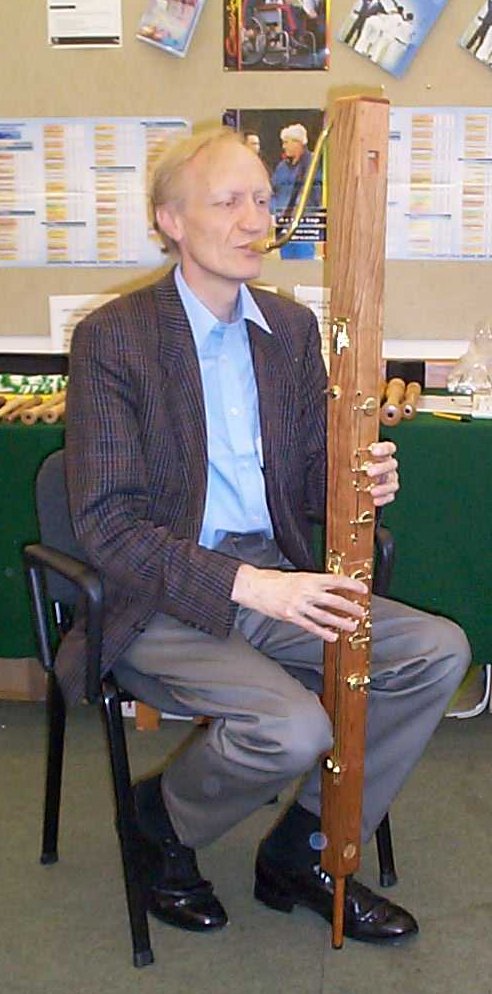
Millennium Great Bass Recorder

Millennium Contra Bass Recorder
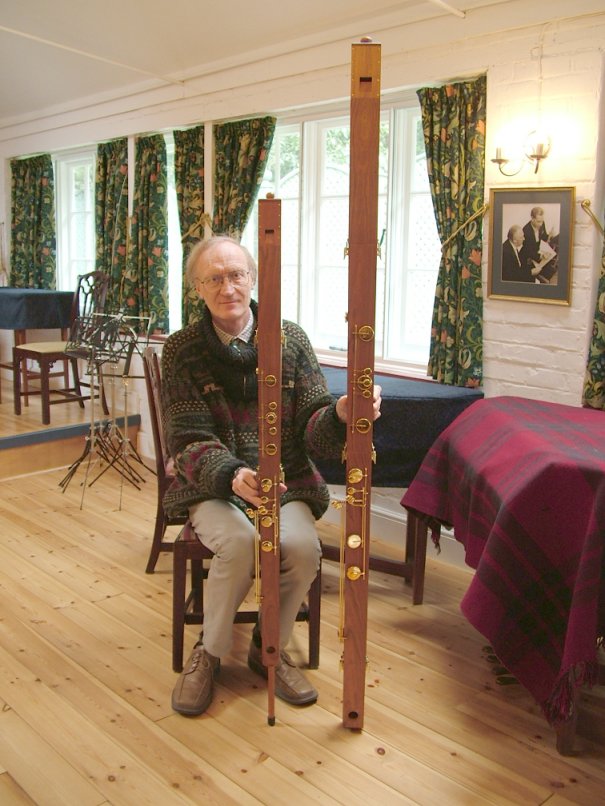 Millennium Great Bass (left) & Contra Bass (right) |
Millennium Recorders Private Comments
Millennium Great Basses in C (modern pitch) and Millennium Contra Basses in F (modern pitch) are now in production Some of our customers have agreed to be approached for comments on specific products purchased from us. Any communication between you and him or her will be entirely private - we neither see what you write nor the answer you receive.
Product: Millennium Great Bass (in C) [29 shipped (as of 15 February 2007) - (a further 20 now in production)]
Customers include: Jim Rowley (UK) (contact for comments) | Bryan Bingham (USA) (contact for comments)
Product: Millennium Contra Bass (in F) [6 shipped (as of 1 March 2007) - (a further 5 now in production)]
Customers include:
Helen Hooker | Stockport Recorder College | The Bristol Branch of the Society of Recorders Players | Swindon Music Centre who have taken delivery of two Millennium Contra Basses (in F) plus one Millennium Great Bass in C
Millennium Recorders Special InformationBinding of one or both of the keys on hole 7a and 7b: Because the key mechanism on the bottom key has a long barrel, one or both of the keys on hole 7 can stick down if the instrument has been subjected to large changes in local humidity or temperature. This problem is well-known to owners of bass clarinets and for exactly the same reason. The recommended solution is to apply a little multigrade oil to each end of the barrel which should prevent recurrence of the problem - alternatively a slight relieving of the barrel will also help although this should be carried out by a qualified wind-instrument repairman.
Weakening of notes on Millennium recorders:
Through extended use or where the instrument is left together for any length of time, the cork seals lose their elasticity and the seals may be no longer airtight. Where this has happened the player will find that the tone of notes originally strong have become noticeably weaker. Depending on which joint seal is faulty, different notes will lose their strength. The problem can be easily fixed by tightening the joint. This is done by fitting a thin sheet of cork to the upper half of the joint (that is to that part of the recorder with the guide holes rather than the fitted brass guide pins). Use a contact adhesive to attach the thin sheet cork to the upper half of the joint - the shape of the finished seal should be the same as the end-on section of the recorder with small holes punched out to take the pins set into the lower half of the jojnt. The cork should be thin enough to make the compression catches harder to lock down but not thick enough to make it impossible to close them at all. Dolmetsch can supply spare sheet cork of a suitable thickness to undertake this simple but effective repair.
Non-standard fingerings on the Millennium Great Bass Recorder (in C):
- Low F natural can be played without holes 7a and 7b
- Middle C sharp/D flat should be fingered 0 alone or 2 3 when the fingering 1 2 is slightly too flat
- All other fingerings are as shown on our English/Baroque Fingering Chart
- for a clear well-in-tune high C sharp/D flat, the fingering is X 1 567, where X is the pinched thumbhole
Non-standard fingerings on the Millennium Contra Bass Recorder (in F):
We regret that our Millennium Square Basses are currently unavailable.
| |